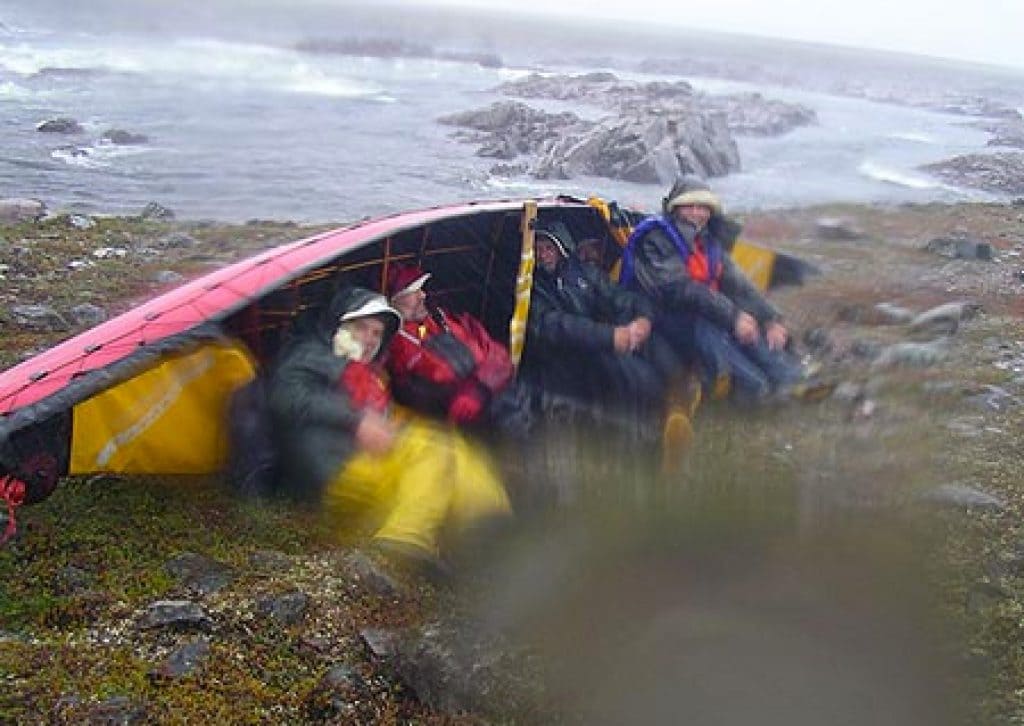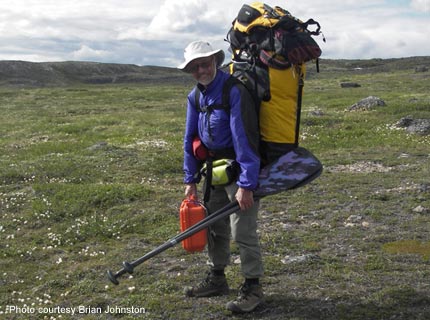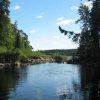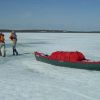Before You Begin Packing: Far North Paddling Tips

Even though the far north is a desert environment, rainy days happen. Look closely and you’ll see the angle of the rain. All photos courtesy Brian Johnston.
The Far North includes rivers that descend from the mountains into the Mackenzie Valley, subarctic rivers that drop off the continental plateau into the ocean, treeless rivers that traverse from one territory to another, and watercourses that link the lands south of the Arctic Circle to watersheds draining into Hudson Bay. The Far North is vast and diverse, so be prepared with the right clothing and equipment. When you are wind bound in a 90 km per hour northwesterly, you’ll be glad you have the right clothing and gear.
My experience has molded my gear list, and I have used my packing list as the basis for this guide. My intent is to help the reader form opinions and make decisions. The gear I suggest is the result of what I’ve seen others using as well as what I continue to use. Each year my outfit becomes more fine-tuned as I replace items and tweak others. I’m particular about what I take and use. My emphasis is on good quality, not necessarily the most expensive, but I’m often putting my comfort, health and even my life in the hands of what I bring so I’m not afraid to spend money.
I also have a definite slant towards efficiency. On the continuum of minimalist to packing everything including the kitchen sink, I’m closer to the minimalist although I do allow some luxuries! This may seem like a long list, but it all fits in a canoe and isn’t that different from a boreal forest canoe trip. Adapt your gear and equipment for remoteness, severe weather, bugs, cold water, and wildlife encounters.
I suggest that paddlers make a list, take it, and keep track of what works and what doesn’t. Jot down your thoughts during the trip and reflect on them afterwards. Memory is selective and smooths out details, but a journal captures the gear that worked and failed. After years of far north tripping, I am still often surprised and glad to see what other canoeists pull out. Over time, your experience and your comfort level may change so be prepared to improve upon what you pack.
I hope this Ultimate Guide helps you decide on clothing and gear for the far north but it will not help you with all the other vital knowledge; judgment, skill, attitude, and experience. And what I suggest may or may not be suitable for you as there are many ways to put together a canoe outfit. It’s important to do additional research, explore your own options, and make your own decisions, especially for safety items. But I hope the tips below—for packing and what to expect in the Far North—will be a good place to start.

Packing Tips
Don’t get hung up on getting all new gear because you’ll miss your favourite equipment if you leave it at home. But don’t just take your usual kit and expect it to perform well under far north conditions. Examine your outfit with a critical eye and decide what gear should work and what equipment needs updating.
Pick out gear by categories to stay focused: on the water, off the water, sleeping, bad weather, cooking, group, personal, etc…
Think about packing light. The less gear you bring, the less you have to portage. ( This could be age-related—as we age we wish to carry lighter loads, but I balance weight with comfort and safety.)
Consider, can you switch to lighter gear? Investigate products geared toward lightness. Also think of multifunctional items—a paddle can serve as a tarp pole. If you do different types of outdoor activities, get gear that works for a range of activities.
Pack some redundant items for back up. I cook with a single burner stove but bring an extra, as there isn’t much wood for fires.
Seek the opinions of others, especially trippers you trust and respect. Attend expositions and symposiums, read gear magazines and online reviews. Ask sales staff at your favorite store.
What to Expect in the Far North
Weather, Wind and Water
The Far North has almost four seasons. I have battled snow in July, and in a treeless land with 24 hours of daylight, when the sun is out it can be boiling hot. There is little or no shade, and your tent will mimic a sauna.
Likewise, without trees for shelter, the wind can howl relentlessly. You’ll travel when the weather and wind allow. And while the far north is similar to a desert in terms of precipitation, with wind, thunder and rain storms can blow in.
Water levels will vary as a result. The desert nature can result in a rapid decline of water levels, and rainstorms run off the land quickly because of the permafrost. Expect water levels to fluctuate quickly, especially on rivers flowing out of the mountains. On the Nahanni River, I spent an entire night dragging canoes and moving gear to higher ground. Unknown to me, the river upstream had experienced a downpour.
And while I have never capsized in the far north, there is a danger of hypothermia as the water is less than 10°C. Some Far North lakes even stay frozen well into July. Every couple of years I have to alter my air charter landing because of an iced over lake. It is a common occurrence to drag over ice or portage past it.
Wildlife, Insects, and Isolation
With remoteness comes the chance to see wildlife. I love the far north for its abundance, and the vistas that aid wildlife viewing. Plentiful wildlife sightings include wolves and bears (black, grizzly, and polar), often following shorelines and coastlines.
Every far north canoe trip will have mosquitoes and black flies. On the Kazan River, biting bugs were horrendous whereas they were almost nonexistent on the Meadowbank and Back Rivers. Expect the insect population to peak in June or July.
Bugs may be abundant and overwhelming but seeing other canoe parties is a rarity. The isolation is one reason I love the far north, but one has to be ready for it.
Next: Canoes and Paddling Gear
 Brian Johnston, Editor of the Paddle Canada Canoe Program. Brian has paddled Far North rivers of all kinds: swift descents from the mountains into the Mackenzie Valley, subarctic rivers emptying into the Arctic Ocean, traverses from the Northwest Territories to Nunavut, and drainages into Hudson Bay.
Brian Johnston, Editor of the Paddle Canada Canoe Program. Brian has paddled Far North rivers of all kinds: swift descents from the mountains into the Mackenzie Valley, subarctic rivers emptying into the Arctic Ocean, traverses from the Northwest Territories to Nunavut, and drainages into Hudson Bay.











My wife and I are thinking about going paddling this summer, so thanks for the tips. I like your point about getting gear that is light or multifunctional. This sounds like a good way to ensure we can carry and fit everything we need.